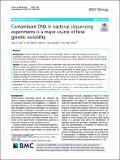Por favor, use este identificador para citar o enlazar a este item:
http://hdl.handle.net/10261/203109COMPARTIR / EXPORTAR:
 SHARE SHARE
 CORE
BASE CORE
BASE
|
|
| Visualizar otros formatos: MARC | Dublin Core | RDF | ORE | MODS | METS | DIDL | DATACITE | |

| Título: | Contaminant DNA in bacterial sequencing experiments is a major source of false genetic variability |
Autor: | Goig, Galo A. CSIC ORCID; Blanco, Silvia CSIC; Garcia-Basteiro, Alberto L.; Comas, Iñaki CSIC ORCID | Fecha de publicación: | 2-mar-2020 | Editor: | Springer Nature | Citación: | BMC Biology 18(1): 24 (2020) | Resumen: | [Background] Contaminant DNA is a well-known confounding factor in molecular biology and in genomic repositories. Strikingly, analysis workflows for whole-genome sequencing (WGS) data commonly do not account for errors potentially introduced by contamination, which could lead to the wrong assessment of allele frequency both in basic and clinical research. [Results] We used a taxonomic filter to remove contaminant reads from more than 4000 bacterial samples from 20 different studies and performed a comprehensive evaluation of the extent and impact of contaminant DNA in WGS. We found that contamination is pervasive and can introduce large biases in variant analysis. We showed that these biases can result in hundreds of false positive and negative SNPs, even for samples with slight contamination. Studies investigating complex biological traits from sequencing data can be completely biased if contamination is neglected during the bioinformatic analysis, and we demonstrate that removing contaminant reads with a taxonomic classifier permits more accurate variant calling. We used both real and simulated data to evaluate and implement reliable, contamination-aware analysis pipelines. [Conclusion] As sequencing technologies consolidate as precision tools that are increasingly adopted in the research and clinical context, our results urge for the implementation of contamination-aware analysis pipelines. Taxonomic classifiers are a powerful tool to implement such pipelines. |
Versión del editor: | https://doi.org/10.1186/s12915-020-0748-z | URI: | http://hdl.handle.net/10261/203109 | DOI: | 10.1186/s12915-020-0748-z | E-ISSN: | 1741-7007 |
| Aparece en las colecciones: | (IBV) Artículos |
Ficheros en este ítem:
| Fichero | Descripción | Tamaño | Formato | |
|---|---|---|---|---|
| 12915_2020_Article_748.pdf | 4,13 MB | Adobe PDF |  Visualizar/Abrir |
CORE Recommender
PubMed Central
Citations
35
checked on 19-abr-2024
SCOPUSTM
Citations
31
checked on 15-abr-2024
WEB OF SCIENCETM
Citations
31
checked on 27-feb-2024
Page view(s)
233
checked on 18-abr-2024
Download(s)
173
checked on 18-abr-2024

